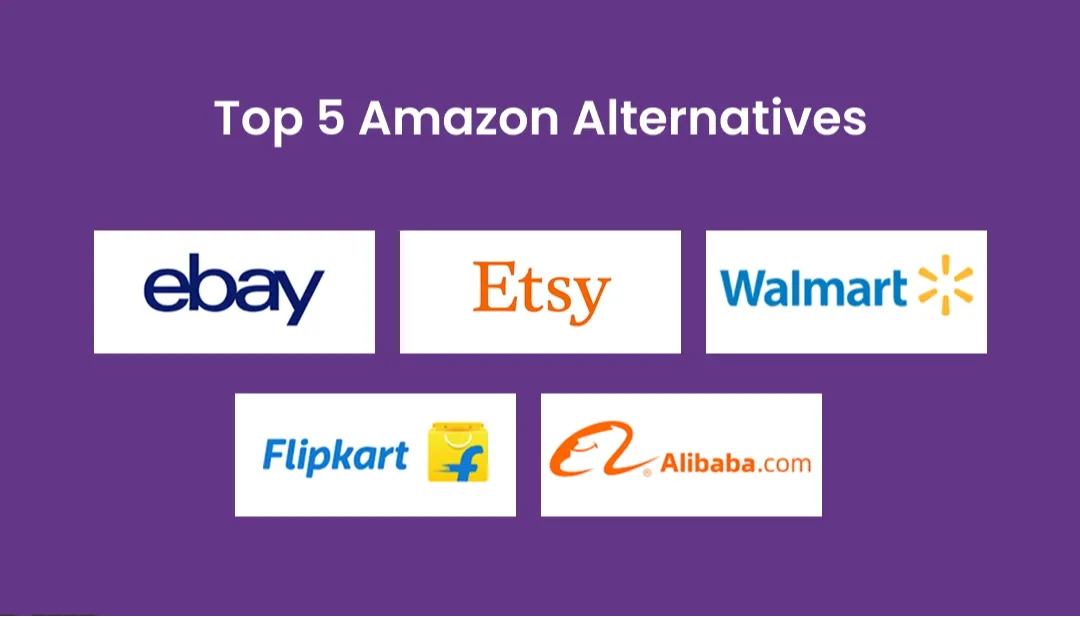How To Create Online Marketplace Like Amazon?
Dipti Singhal
Aug 26, 2025

The buzz of online shopping is growing rapidly; multi-vendor marketplaces have redefined how people buy and sell online. Giants like Amazon, eBay, and Etsy have transformed traditional retail and set the benchmark for scalable, user-centric eCommerce ecosystems. With the potential to generate high revenue, offer limitless product variety, and empower third-party sellers, building a online marketplace like Amazon has become a lucrative opportunity for entrepreneurs and businesses.
But how to create an online marketplace like Amazon that can compete and resemble the success of Amazon? In this blog, we’ll guide you through the essential steps, technology stack, and strategies to create a multi vendor marketplace website like Amazon from scratch. Whether you're a startup founder, a business owner, or a tech enthusiast, this comprehensive guide to building a website like Amazon will help you understand what it takes to bring your marketplace vision to life.
Amazon’s Growth Story: What Makes Amazon So Successful?
Amazon’s journey from a small online bookstore ran in a garage, but over the years, it has turned into the biggest online shopping platform in the world. With a relentless focus on innovation, customer satisfaction, and operational excellence, Amazon has reshaped global retail and set the gold standard for multi-vendor platforms. Its ability to scale rapidly, empower third-party sellers, and offer an unmatched product variety has made it a powerhouse in the digital economy.
Understanding Amazon’s success story is crucial for anyone aiming to build a similar website like Amazon. By examining the strategies, technologies, and core principles that fueled Amazon’s growth, aspiring entrepreneurs can gain valuable insights into what it takes to thrive in the competitive world of online marketplaces. In this blog, we’ll explore the key reasons behind Amazon’s massive growth and how you can apply similar ideas for a successful bc2 ecommerce app development like Amazon of your own.
Reasons to Invest in Building a Marketplace Like Amazon
Building a multi-vendor marketplace website like Amazon may seem like a big challenge, but it can also be one of the smartest investments you make. Amazon-like marketplaces have completely changed the way people shop, and they continue to grow fast, offering a lot of opportunity for entrepreneurs and businesses. Here are some key benefits of investing in Amazon like ecommerce app development:
1. Multiple Revenue Streams
A marketplace like amazon doesn’t just earn money from product sales. You can generate income through seller fees, advertising, featured listings, subscriptions, and even delivery services. These different streams help you start an ecommerce business.
2. Low Inventory Risk
Unlike traditional eCommerce businesses, you don’t need to manage your own inventory. Since third-party sellers list and ship their own products, you can focus on managing the platform and improving user experience, without worrying about stocking products or warehouse management.
3. Fast Scalability
Ecommerce marketplaces like Amazon grow quickly because they connect buyers and sellers in one place. The more sellers you bring on board, the more products are available, which attracts more buyers. This “network effect” makes it easier to scale your business over time.
4. Global Reach
With the right setup, a marketplace can reach customers all over the world. You’re not limited to a single location or market. Amazon like ecommerce website development allows for huge growth potential if you plan for international audiences.
5. Strong Brand Value Over Time
A well-designed marketplace builds trust and brand loyalty. As more people use your platform, it becomes a go-to destination for online shopping in specific niches or regions, just like Amazon did. This long-term brand value makes your business more attractive to investors and buyers.
6. Data-Driven Growth
Online ecommerce websites like Amazon collect a lot of useful data, like what people buy, when they buy, how much they spend, and what products are trending. You can use this information to improve the user experience, introduce new features, and make smarter business decisions.
Steps to Create a Ecommerce Website Like Amazon?
Creating a website like Amazon might sound like a big task, but with the right development plan, team, and technology, it’s absolutely possible. Amazon is a multi-vendor marketplace, meaning it allows many different sellers to list and sell their products in one place. If you want to create an multi vendor marketplace website like Amazon, here’s a step-by-step guide to help you get started:
1. Understand the Business Model
Before starting the web or app development, you have to clear your mind about how your marketplace will work. Will you sell products directly, or just let other sellers list theirs? Will you charge a fee, take a commission, or offer subscriptions? Knowing your business model helps you make smart decisions later.
2. Choose a Niche
While Amazon sells everything, it’s good to start from a small niche, choose some popular products like electronics, fashion, handmade goods, or eco-friendly products. This makes it easier to attract your first sellers and buyers.
3. Plan the Key Features
While developing a marketplace like amazon you should add features for three main users: customers, sellers, and admins. Here are some essential ones:
-
For Customers: Product search, filters, reviews, cart, wishlist, checkout, payment options, order tracking.
-
For Sellers: Seller dashboard, product upload, order management, analytics, payout settings.
-
For Admins: Site settings, user management, product approval, commission settings, reports.
4. Choose the Right Tech Stack
You can build a site like amazon from scratch or use ready-made marketplace platforms like Magento, WooCommerce (with multi-vendor plugins), Shopify Plus, or Sharetribe. For a custom site, you’ll need technologies like:
-
Frontend: HTML, CSS, JavaScript (React or Vue.js)
-
Backend: Node.js, Laravel, or Django
-
Database: MySQL, PostgreSQL, or MongoDB
-
Cloud & Hosting: AWS, Google Cloud, or DigitalOcean
5. Hire the Right Development Team
Unless you’re a developer yourself, you’ll need an experienced software developers team for hire to bring your idea to life. Look for experts in web development, UI/UX design, and marketplace functionality. A ecommerce development company like IMG Global Infotech can help you build a powerful and scalable online store solution.
6. Set Up Secure Payment Systems
Integrate payment gateways like Stripe, PayPal, Razorpay, or Cashfree on amazon like ecommerce platforms to support smooth transactions. Make sure sellers can receive payouts easily, and that customers feel safe making purchases on your platform.
7. Test and Launch Your Marketplace
Before going live, test everything, from product uploads to checkout. Fix bugs, improve the design, and make sure your website like Amazon works smoothly on mobile and desktop. Once ready, launch a beta version to gather feedback before scaling.
8. Promote and Grow Your Platform
Use digital marketing, SEO, paid ads, and social media to attract both buyers and sellers. Consider referral programs, discounts, and featured listings to keep users engaged and coming back.
How Much Does It Cost to Make a Website Like Amazon?
Cost to create online marketplace like Amazon can range between $15,000 to $49,000+, depends on many factors such as features, design complexity, development time, and the experience and location of the development team. Below is a detailed cost breakdown to help you understand what it takes to build a full-featured, scalable eCommerce marketplace like Amazon.
>>> Also Read: Ecommerce App Development Cost
Key Features of a Multi-Vendor Marketplace Like Amazon
To build a successful marketplace like Amazon, you need more than just a list of products. The platform must offer a smooth experience for customers, reliable tools for sellers, and powerful controls for admins. Here's a breakdown of the most important features you should include in app like Amazon:
Customer Features
These are the features your buyers will interact with when shopping on your platform.
-
User Registration & Login: Simple sign-up with email, mobile, or social login options (Google, Facebook, Apple).
-
Advanced Search & Filters: Powerful search with filters for price, category, brand, rating, availability, and more.
-
Product Listings: Clear product descriptions, high-quality images, price, discounts, specifications, and stock status.
-
Add to Cart & Wishlist: Shoppers can add items to their cart or save them for later in a wishlist.
-
Secure Checkout & Multiple Payment Options: Support for credit/debit cards, UPI, net banking, wallets, PayPal, and cash on delivery.
-
Order Tracking: Real-time tracking from order confirmation to delivery, with notifications.
-
Product Ratings & Reviews: Customers can read and leave honest reviews, helping others make informed decisions.
-
Personalized Recommendations: AI-driven suggestions based on browsing and purchase history.
-
Multilingual & Multi-Currency Support: Especially useful if targeting global markets.
-
Customer Support Chat: In-app messaging or chatbot for real-time help.
Seller (Vendor) Features
These tools help third-party sellers manage their storefronts and orders efficiently.
-
Seller Registration & KYC Verification: Secure onboarding process with identity verification.
-
Seller Dashboard: Overview of sales, earnings, inventory status, and recent activity.
-
Product Management: Easy upload/edit of products, descriptions, prices, and stock levels.
-
Order & Return Management: View, accept, or cancel orders and manage returns or refunds.
-
Sales Reports & Analytics: Visual charts and data to track performance and improve business strategy.
-
Customer Interaction: Answer customer queries or reviews directly.
-
Commission & Payout Settings: Track platform fees and request withdrawals.
Admin Panel Features
The admin manages the entire platform, users, listings, transactions, and more.
-
Dashboard Overview: Snapshot of total sales, active sellers, customer activity, and system alerts.
-
User Management: Control access for buyers, sellers, delivery agents, and support staff.
-
Product & Category Management: Approve listings, organize categories, and manage tags or filters.
-
Commission & Tax Settings: Define commission rates, taxes, shipping fees, and seller earnings.
-
Content Management System (CMS): Update banners, static pages, announcements, and blog posts.
-
Report Generation: Export detailed reports on sales, refunds, inventory, and traffic.
-
Security Controls: Fraud detection, login history, ban/suspend users, and monitor suspicious activity.
Top 5 Amazon Alternatives to Study

Before you start building your own eCommerce platform, it’s smart to study other successful marketplaces besides Amazon. These platforms offer valuable insights into different business models, features, and customer strategies that you can learn from and apply to your own project.
Here are 5 top Amazon alternatives worth exploring:
1. eBay
-
Business Model: Auction + Buy It Now marketplace
-
Key Takeaway: eBay was one of the first peer-to-peer marketplaces. It shows how you can succeed even without holding inventory by connecting individual sellers and buyers.
-
Learn From: Seller ratings, buyer protection policies, and international shipping strategies.
2. Walmart Marketplace
-
Business Model: Retail + third-party sellers
-
Key Takeaway: Walmart competes directly with Amazon and has grown its online marketplace rapidly by leveraging its brand trust and physical store network.
-
Learn From: Omnichannel strategies, fast delivery partnerships, and competitive pricing.
3. Etsy
-
Business Model: Niche marketplace for handmade, vintage, and unique products
-
Key Takeaway: Building a website like Etsy proves that focusing on a niche audience can be more effective than trying to sell everything.
-
Learn From: Community building, seller empowerment, and product personalization.
4. Alibaba
-
Business Model: B2B and B2C global marketplace
-
Key Takeaway: Alibaba dominates in wholesale and international trade, offering lessons in scaling globally and managing bulk transactions. Aliexpress alternative is also a greate marketplace like Amazon.
-
Learn From: Supplier management, cross-border payments, and logistics solutions.
5. Flipkart
-
Business Model: Full-fledged eCommerce with third-party sellers
-
Key Takeaway: Flipkart is a major Amazon alternative in India, known for its localized approach, regional language support, and focus on customer experience in emerging markets.
-
Learn From: Local marketing strategies, payment methods (like cash on delivery), and festive-season sales.
>>> Also Read: Cost To Build An App Like Flipkart
How Does Amazon Make Money?
Ecommerce websites like Amazon may have started as a simple online bookstore, but today it earns money from many different sources. It's not just about selling products anymore, but has built an entire ecosystem that brings in revenue from a variety of services. Here’s a breakdown of the main ways how to make money on Amazon:
1. Online Retail Sales
This is Amazon's most well-known business. It sells millions of products directly to customers, everything from books and clothes to electronics and household items. Customers order online, and Amazon handles the delivery. While this part of the business has smaller profit margins, it brings in a huge chunk of the company’s revenue.
2. Third-Party Seller Services
Amazon allows other businesses to sell their products on its platform. These third-party sellers use Amazon’s tools, such as product listings, advertising, shipping, and customer service. In return, Amazon charges them fees. This is a major source of profit because Amazon earns money without having to stock or ship those products itself.
3. Amazon Web Services (AWS)
AWS is Amazon's cloud computing division. It helps businesses run their websites, apps, and data storage in the cloud. Companies like Netflix, Airbnb, and even government organizations use AWS. It's one of the most profitable parts of the marketplace like Amazon’s business and brings in billions of dollars every year.To make informed decisions about using these services, understanding AWS Bedrock pricing further helps businesses plan and optimize their cloud costs effectively.
4. Subscription Services
Amazon also makes money through subscriptions. The most popular one is Amazon Prime, which gives members free shipping, access to movies, music, and more. Other subscriptions include Kindle Unlimited and Audible. These services bring in steady, recurring revenue each month.
5. Advertising
Yes, Amazon makes money from ads too. When you search for something on Amazon, you’ll often see “sponsored” products at the top. Brands pay Amazon to promote their products, and this advertising business has grown rapidly over the years.
6. Physical Stores & Devices
Amazon also owns physical stores like Whole Foods and Amazon Go, and it sells devices like Alexa, Kindle, and Fire TV. While these make up a smaller portion of its revenue, they still contribute to the company’s overall earnings and brand presence.
Why Choose IMG Global Infotech to Create a Multi-Vendor Marketplace Website Like Amazon?
If you're planning to create a multi-vendor marketplace website like Amazon, IMG Global Infotech is the ideal technology partner to bring your vision to life. With years of experience in eCommerce marketplace development, we deliver custom-built platforms that are scalable, secure, and user-friendly.
Our team handles everything from UI/UX design to mobile app development, third party integration, and post-launch support. Whether you're targeting a niche or large-scale audience, we ensure your marketplace runs smoothly across all devices. With transparent communication, timely delivery, and a focus on quality, IMG Global Infotech helps you launch a high-performance multi vendor marketplace like amazon that connects buyers and sellers seamlessly.
Dipti Singhal is a skilled Content Writing Specialist at IMG Global Infotech, with strong expertise in creating engaging, SEO-optimized content for various industries. She focuses on blending storytelling with effective keyword strategies to help businesses connect with their audience and improve their online visibility. Passionate about delivering high-quality content that drives real results, Dipti plays an essential role in strengthening the company’s digital presence.












